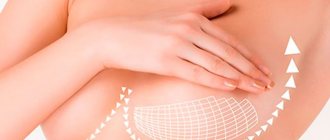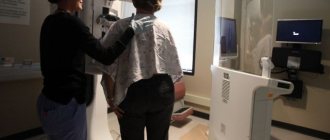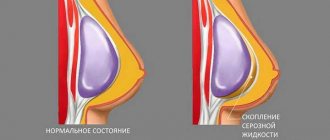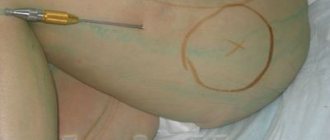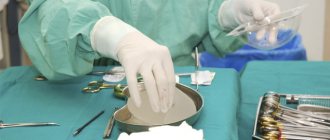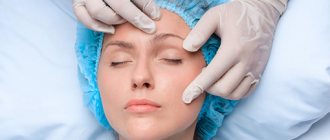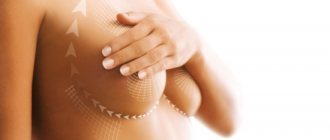» Plastic surgery » Breast reconstruction
- Why is breast reconstruction necessary?
- How can you restore your breasts?
- Breast reconstruction with silicone implants
- Breast reconstruction using your own tissue
- Breast reconstruction using combined techniques
- Reconstruction of the nipple and areola; lipofilling
The mammary gland is a part of the body that plays a huge role in the life of a woman of almost any age. Unfortunately, among female cancer pathologies, breast cancer is the most common event. In some cases, when the tumor is detected in the early stages, organ-preserving treatment is possible, but in most cases, surgical treatment consists of a mastectomy - complete removal of the mammary gland.
Breast reconstruction allows you to restore the appearance of a lost breast and is a very popular technique throughout the civilized world.
In leading clinics, including the Century Clinic, breast reconstruction is performed simultaneously with mastectomy, which allows saving most of the breast skin, and in some cases, the nipple and areola. The clinic uses various methods for breast reconstruction after mastectomy, which, even if it is completely removed in another institution, allows you to restore the aesthetic appearance of the lost mammary gland. This type of reconstruction is called delayed.
Indications for breast reconstruction with lipofilling
- The patient requires breast reconstruction after a mastectomy, when there is a problem of lack of tissue for prosthetics.
- Failure or inability of the patient to undergo complex traumatic operations associated with the formation of new scars in the donor area.
- The patient’s desire to avoid the use of implants and other foreign objects during breast reconstruction.
- The desire to heal and rejuvenate the skin, create a reservoir and stretch internal tissues for subsequent prosthetics.
- Carry out reconstruction using the most gentle method possible, with comfortable rehabilitation and minimal risk of complications.
Constant wearing: what to buy
There are four types of products that you will need to create daily comfort in your everyday life.
1. Clothes
Blouses, T-shirts, pajamas, shirts, dresses, tops, sports T-shirts - these products are designed to be worn without a bra because they have a built-in - sewn-in bodice with pockets to support and secure the prosthesis.
2. Bras
The underwear is tailored in such a way that, thanks to the high neckline, a complete fit of the prosthesis is ensured, scars and uneven postoperative surfaces are hidden. Cups with pockets are responsible for reliable fixation and correct anatomical placement of the breast and prosthesis in the bra, without direct contact of the prosthesis with the body. Wide, ergonomic straps guarantee the prevention of lymphedema and relieve stress from the neck and shoulders - with a heavy bust. The high armhole hides tissue deficiency in the armpit area and provides wearing comfort. The wide belt under the chest does not put pressure on the diaphragm, ensuring free breathing and eliminating discomfort in the stomach area.
3. Swimwear
Swimsuits are tailored like bras, have a stylish appearance, and can be either separate or one-piece.
4. Dentures for permanent wear for an attractive appearance
Modern prosthetics provide natural sensations and behavior. They are soft to the touch, sway when walking and “fall off” when lying down. Designed with a special thin edge - it provides a delicate fit in the sensitive seam area and a natural transition to the lines of the body.
These products are made taking into account the various features of the female breast: full-bodied and lightweight, triangular and teardrop-shaped. They also minimally touch the body, so they do not overheat it - there is no increased sweating, and a natural microclimate is maintained.
The essence of the method of breast reconstruction using lipofilling
Our clinic has developed a technique that allows women to recreate lost breasts. The difficulty of reconstructive surgery often lies in the fact that the tissues lose their elasticity, and rough scars exist not only on the outside, but also on the inside. Therefore, the first stage of the operation is tissue preparation, which we carry out using the American BRAVA system. Thanks to the BRAVA system, we are able to stretch and prepare the skin, as well as gain space for the subsequent introduction of a fat graft into the breast (lipofilling) and improve the survival of fat cells in the postoperative period.
The next step is to restore the breasts with our own fat cells, which we take from the patient’s donor areas, thereby creating a fat layer that will later allow us to get natural breasts. In addition, adipose tissue has other advantages: it secretes growth factor, which has a beneficial therapeutic effect on scars in the transplantation area.
The last stage is the formation of the nipple and areola. In many cases, it is necessary to perform surgery on both mammary glands at once in order to achieve symmetry. To do this, if necessary, a second breast lift, reduction or prosthetics is performed. Our method allows you to carefully and correctly restore the mammary glands, without leaving additional scars or scars on the body. Usually, operated patients (even those who had some doubts before the operation) would never take a step back - their moral and aesthetic satisfaction is truly great.
- In preparation for surgery, the patient wears special vacuum external expanders, often at night.
- To stretch the skin and create a reservoir, as well as improve tissue health, the first stage of lipofilling is performed. The fat tissue obtained during liposuction is prepared and injected into the breast area.
- To form the required shape and volume, an additional fat autograft is introduced into the already prepared tissues. At the patient's request, breast prosthetics are performed. Often a simultaneous operation is required on a healthy breast to create symmetry.
- A vacuum system of external expanders is used to ensure engraftment of the injected fat cells.
About experiences and complications
The most important thing is behind us - the operation is done. Life saved.
But the feeling of anxiety continues to live. Now for other reasons.
How now, after the operation, will people around you perceive your body? After all, you want to be beautiful and be liked - in the mirror, by the man you love, to be on an equal footing with your friends. I want to live my life as before, and not have anything overshadow the joy of simple things. Just relax and feel as attractive as before. Realize that everything is okay.
And as soon as all these normal desires are formed, embarrassment and confusion immediately appear. Self-confidence as a woman quickly declines. Sadness takes its place.
Yes, there are tasks that can become reality and for which you need to remain fully prepared:
- physical features: lymphedema, uneven suture, partial resection, stiffness, sweating, weight change, spinal problems;
- psychological state: sadness and confusion about what and how to do next.
And here we want to draw attention to the recommendations and products we offer. Because they are designed specifically to restore a woman’s previous comfort and maintain her health.
How is breast reconstruction performed using lipofilling?
The plastic surgeon determines the areas suitable for harvesting adipose tissue and the approximate number of operations that will be needed to achieve the most aesthetic result. The system of vacuum external expanders is a special bra cup in which a vacuum pump creates negative pressure. For three to four weeks before the operation, the patient uses the system daily for 10-12 hours. The operation is performed under general anesthesia; preoperative preparation, which includes all the necessary tests, is mandatory. The collection of adipose tissue for lipofilling is carried out using special thin cannulas through small punctures; traces of this procedure are leveled over time and will not be noticeable. By forming microtunnels, the surgeon introduces fat cells in small doses for their best engraftment. Using back-and-forth movements, the surgeon fills the deep layers of tissue with the patient’s own fat, then the superficial ones. After the operation, the patient is put on a system of vacuum expanders - it mobilizes the transplanted fat cells, resulting in the formation of new blood vessels and protects the breast from external factors and trauma. The reconstruction takes place in several stages with the necessary time intervals for recovery. The transplanted fat cells make the tissue healthier and more elastic; if the patient wishes, the final stage of breast reconstruction can be the installation of an implant to give the breast volume and a more curvaceous shape.
When is it possible
Many women (especially young ones) think about breast reconstruction even before breast removal or immediately after. But the question of when restoration can be carried out cannot be answered unambiguously. Much depends on the stage of the disease and the type of tumor associated with the risk of relapse, as well as on whether the patient has had radiation and/or chemotherapy or is just about to undergo it. Therefore, this question should only be addressed to your doctor. You cannot begin plastic surgery until postoperative treatment has been completed in full.
From stress to obesity. Doctor about factors influencing the development of breast cancer Read more
In addition, there are contraindications, both absolute, which make such an operation impossible in principle, and relative (in this case, the intervention will have to be postponed until better times). Among the absolute contraindications:
- late stage or locally advanced breast cancer (from stage IIIb), as well as combined cancer;
- severe concomitant pathologies (including diabetes mellitus, poor blood clotting, dysfunction of the endocrine system);
- relapse of the disease.
Article on the topicWhere are the wizards? How to choose a plastic surgeon
Relative contraindications are:
- unfavorable molecular type of breast cancer (this is a conditional contraindication, it only indicates an increased risk of relapse);
- infectious diseases and any diseases in the acute stage;
- diseases of the mammary glands (including mastopathy);
- chronic purulent processes;
- minor age;
- pregnancy;
- pronounced radiation reaction of the skin after radiotherapy.
Nipple tattoo
To restore the shape and volume of the breast, there are many methods of reconstructive surgery, and to restore the aesthetic side - tattooing, as a way to restore the nipple-areolar complex. A specialist uses pigments to graphically recreate their relief and structural features. Tattooing is performed on both breasts to achieve a uniform color. As a rule, at least three colors of implanted pigments are used simultaneously to work on the nipple-areolar complex. The pigments for dermatopigmentation used in the clinic are a certified, modern complex product, do not cause irritant reactions, do not come into contact with organic tissue and are not excreted through the lymphatic channel. New generation pigments are resistant to various factors (such as ultraviolet radiation). Stable fixation in the skin is guaranteed by the optimal molecular size (about 6 microns). Modern anesthetics make the procedure painless.
Beneficial physical activity
Rules for caring for your health:
1. Swimming. Water soothes, has a gentle massaging effect, and the hand recovers faster. Lymph outflow is normalized. The swelling subsides.
2. Exercise. Simple to do but very effective. They will easily become a daily habit.
- “Combing your hair” Place your elbow on the edge of your bedside table. Keep your head straight. Start by combing one half of your head, then gradually move to the other. Don't get overwhelmed, but be persistent;
- “Ball” Clenching and unclenching the hand. Use a rubber ball or other object, squeezing it in your palm;
- “Drying your back” Using a towel or similar object, make gentle movements that simulate drying your back. Repeat on both sides.
3. Wearing a compression sleeve. It is necessary to prevent the occurrence of edema and the threat of lymphedema. Therefore, it needs to be worn under load: work in the country, household chores, flights or a long road. If you couldn’t put on a sleeve during physical activity, be sure to put it on afterwards. Agree that it is better to wear a prophylactic sleeve during exercise than to constantly wear a therapeutic compression sleeve if lymphedema begins to develop.
Recovery period
Possible side effects after breast reconstruction surgery include breast tenderness and pain, as well as stiffness.
This can last up to 2 months. Breast reconstruction is a major operation. In both cases - both with implant restoration and soft tissue transplantation - the patient may require constant medical supervision and stay in the hospital for several days after surgery.
It is possible that more than one operation may be required for complete breast reconstruction. And transplantation may entail a longer recovery period than reconstruction using implants. In both cases, the recovery period can be extended if the patient’s body requires it.
During the first two months, a woman undergoing breast reconstruction surgery may experience and observe:
- fatigue;
- bruising, swelling and tenderness in the chest and in the area from which the skin graft was removed;
- stiffness in movement, for example, the inability to raise your arms above your head.
The patient should also be prepared to have stitches that may need to be removed and drainage tubes for some time after surgery.
During the initial recovery period, your doctor may prescribe pain relievers to make the recovery process more comfortable and advise you to wear an elastic, supportive bra to reduce swelling.
Reconstructed breasts will not look exactly the same as natural breasts and will feel different. However, after a few years, partial or complete sensitivity in this area may return.
| FAYAZOV Eduard Nurutdinovich Plastic surgeon With reconstructive mammoplasty, compared to aesthetic surgery, a longer period of hospital stay for the patient is required, the recovery period will be more difficult (special exercises are required), and all the basic recommendations related to the underlying disease. |
Postmastectomy syndrome
To quickly return to a full life, a woman needs rehabilitation after a mastectomy. A sanatorium is an ideal option, but due to the modern rhythm of life, not every woman can afford to leave her family for a long time. Rehabilitation centers have been created for such patients, one of which operates at the Yusupov Hospital.
Specialists at the rehabilitation center carry out a number of preventive measures to prevent postmastectomy syndrome, which is accompanied by quite serious complications:
- severe lymphedema;
- deformation of the spinal column and poor posture;
- severe pain syndrome;
- scar formation;
- dysfunction of the shoulder joint;
- depressive syndrome;
- severe pain in the neck and back.
Rehabilitation after breast mastectomy begins immediately after the operation.
Specialists at the Yusupov Hospital prescribe a special daily regimen and physical therapy for patients. Physiotherapy after breast removal is selected individually, taking into account the woman’s general condition. Without early rehabilitation, it is almost impossible to restore the mobility of the upper limbs and prevent poor posture and stooping.
Often, women who have undergone surgical removal of the mammary gland experience depression. In such cases, they need psychological help to improve their emotional health.
With the development of lymphedema, photodynamic therapy is prescribed, which is an effect on the edema area using incoherent monochromatic radiation. Thanks to this treatment, erysipelas, rashes and minor bleeding, which often accompany complicated stages of lymphostasis, are eliminated. Photodynamic therapy has a stimulating effect on local tissue immunity, helps reduce swelling and improve venous blood flow.
In addition, metabolic treatment is prescribed - taking antioxidant drugs. Venotonics, diuretics and agents that stimulate lymphatic drainage help reduce lymphatic edema. The use of massage, which improves blood and lymph circulation and restores normal blood flow in the affected limbs, is also effective.
To reduce edema in the rehabilitation center of the Yusupov Hospital, great importance is also paid to the nutrition of patients. A salt-free diet with plenty of fiber and vitamins is prescribed.

